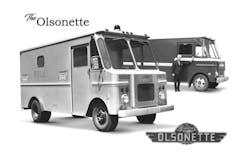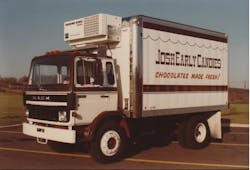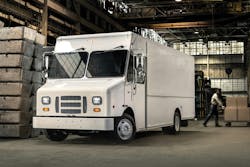Forty years ago in 1985, JB Poindexter and Co., a manufacturing conglomerate of work truck and van products, was just getting started. Since then, JBPCO and its nine business units have grown so valuable for the industry that if JBPCO were “vaporized today,” the industry would be in a state of “severe distress,” owner John Poindexter told FleetOwner.
“A lot of competitors couldn’t begin to fill the void that we would have left behind,” he said.
That void would be felt immediately in products such as step van bodies, service and utility bodies, and more. According to JBPCO’s website, the company’s Morgan Truck Body business unit has 45% of the medium truck body market share, while Poindexter said it's closer to 50%. The Morgan Olson brand takes 66% of the market share in step vans, according to the JBPCO website, and has 90% of the Class 5 delivery market, Poindexter said.
While not at the top, Reading Truck, another JBPCO business unit manufacturing service and utility bodies, is “a strong No. 2” in its segment, Poindexter said.
JBPCO continues to grow. Even during what’s been dubbed an “uncertain” year for the industry, JBPCO is planning another acquisition in 2025, and while Poindexter didn’t share details, he said the move was significant.
How JBPCO got its start
Poindexter, 80, is a decorated Army veteran who was once responsible for up to 250 servicemen in the Vietnam War. It was this experience that developed Poindexter's decisiveness and his knack for rapid decision-making.
After Poindexter served in the military, he got his professional start in finance.
“I had a career in venture capital that was a mediocre success and a career in corporate finance, which was not successful,” Poindexter said. “Then I discovered the art and science of leveraged buyouts."
In 1985, JBPCO acquired its first business, a polystyrene packaging business, EFP, that the company still owns today. The investment was a success, allowing JBPCO to acquire another business and then another.
The acquisitions continued. By 2004, JBPCO’s investment banker advised Poindexter that the “‘days of disassociated conglomerates are over ... take your business, and find a theme,’” Poindexter recalled.
This resulted in the sale and purchase of several business units, which Poindexter described as “a sudden change” that “took several years to implement.” That change helped JBPCO become what it is today—a manufacturing powerhouse with a focus on the commercial vehicle industry.
See also: How to build a fleet future during times of uncertainty
Corporate size, small-business culture
JBPCO is a $2.5 billion corporation employing 8,500 individuals across North America, and its upcoming acquisition is on track to bring JBPCO to a total of $3 billion in revenue. But while it is a large corporation, Poindexter said he runs JBPCO quite differently from other businesses of its size.
“There is very little bureaucracy here,” Poindexter said, and only a handful of senior executives are involved in decision-making. Other times, decisions are made by the board, which is composed of two people: John Poindexter and a retired employee of JBPCO. It’s these aspects of JBPCO that allow it to generate decisions much quicker than the average business of an equal size.
Poindexter made it clear that he relies heavily on his senior executives—those who run JBPCO’s business units. He said they make decisions about the brands they lead while he focuses on the bigger picture and the parent company.
Proper leadership is so crucial to Poindexter that JBPCO hires senior executives using a recruitment process. Once recruited, Poindexter himself conducts their first interview to “ensure, before we seriously get going, that we have executives who are going to fit in and match our very middle-class-origin mode of doing business,” Poindexter said.
Today, JBPCO’s senior executives resemble Poindexter’s dream team. “This is the first time that I can say in my career ... there's no senior executive that I would take out of our business,” he said.
While a conglomerate, Poindexter also gives senior executives of each business unit autonomy with business initiatives and cultures. For example, FleetOwner has covered Morgan Truck Body’s Women’s Initiative Network, which seeks to foster women’s growth within the business unit. As a veteran, it’s also important to Poindexter that each business unit hires veterans.
These initiatives “reflect our broader effort to foster a culture of inclusion, opportunity, and respect. While each business unit takes its own approach, we’re proud of the values and culture that continue to take shape across the enterprise,” Poindexter said.
What’s next for JBPCO?
A more recent update from JBPCO is the development of EAVX back in 2021. EAVX is a JBPCO business unit designed in-house as the company’s innovation hub. It was a direct response to the electrification of the industry, but it’s also helping JBPCO innovate for the future.
“EAVX was formed because we were petrified at the rapidity of change in the commercial truck business in the direction of alternative fuels,” Poindexter recalled. “Its charter was to get us in the electric and alternative fuels business. And we did so. We’re the producer of bodies and trucks for quite a number of ... EV manufacturers.”
EAVX was instrumental in building a partnership between JBPCO’s Morgan Olson brand and Rivian, with Morgan Olson supplying bodies for the EV manufacturer’s commercial van product.
But EAVX has evolved even further. Poindexter said it is now also the “technology-leading prototyping collaborator” with JBPCO’s different business units. EAVX has supported JBPCO’s business units with the design of electrical systems, casket systems for the company’s hearse upfit brand, and is even working with General Motors and Cadillac to develop an electric hearse.
Forty years in business is a crowning achievement, but pomp and circumstance aren’t JBPCO’s style.
“We're a very modest company, and we're not making a big deal out of this,” Poindexter said. The company held a press conference commemorating its 40th anniversary at NTEA’s Work Truck Week in March, but that is the extent of JBPCO’s plans for celebration, Poindexter said. Instead, Poindexter’s focus is on gratitude.
“Four decades is a long time to be in business these days in our field, and we're proud of that,” he said. “We're proud of the contributions ... of our team members. We're proud of the customer relationships we've developed with some of the finest—nearly all the finest—names in commercial transportation outside of Class 8. Our vendors are a forgotten part of many businesses, but to us, they're very important. We have a well-developed supply chain, and we exercise it strenuously.”
While Poindexter has been at the helm for 40 years and has earned a break, he has no plans to retire. He said his motivation to continue working comes from the fulfillment he receives from the company’s achievements and strong performance for the corporation, for its customers, vendors, and partners. And for JBPCO’s next several years, Poindexter plans to lead full steam ahead.
“I think we have broken the code for our mode of operation,” Poindexter said when asked about his goals for JBPCO’s future. “We want to do what we’re doing today more, and better, and bigger. We'll continue to make acquisitions that are in the commercial space ... And I believe we’ll be substantially larger.”
JBPCO was built with a focus not on trends but “on long-term value, operational discipline, and resilience,” Poindexter said, and over these past 40 years, the company has navigated “deregulation, globalization, labor shortages, and four recessions.” With Poindexter’s executive dream team, current industry relationships, and the support of the group’s innovation hub, JBPCO’s next 40 years are poised for whatever comes next.







